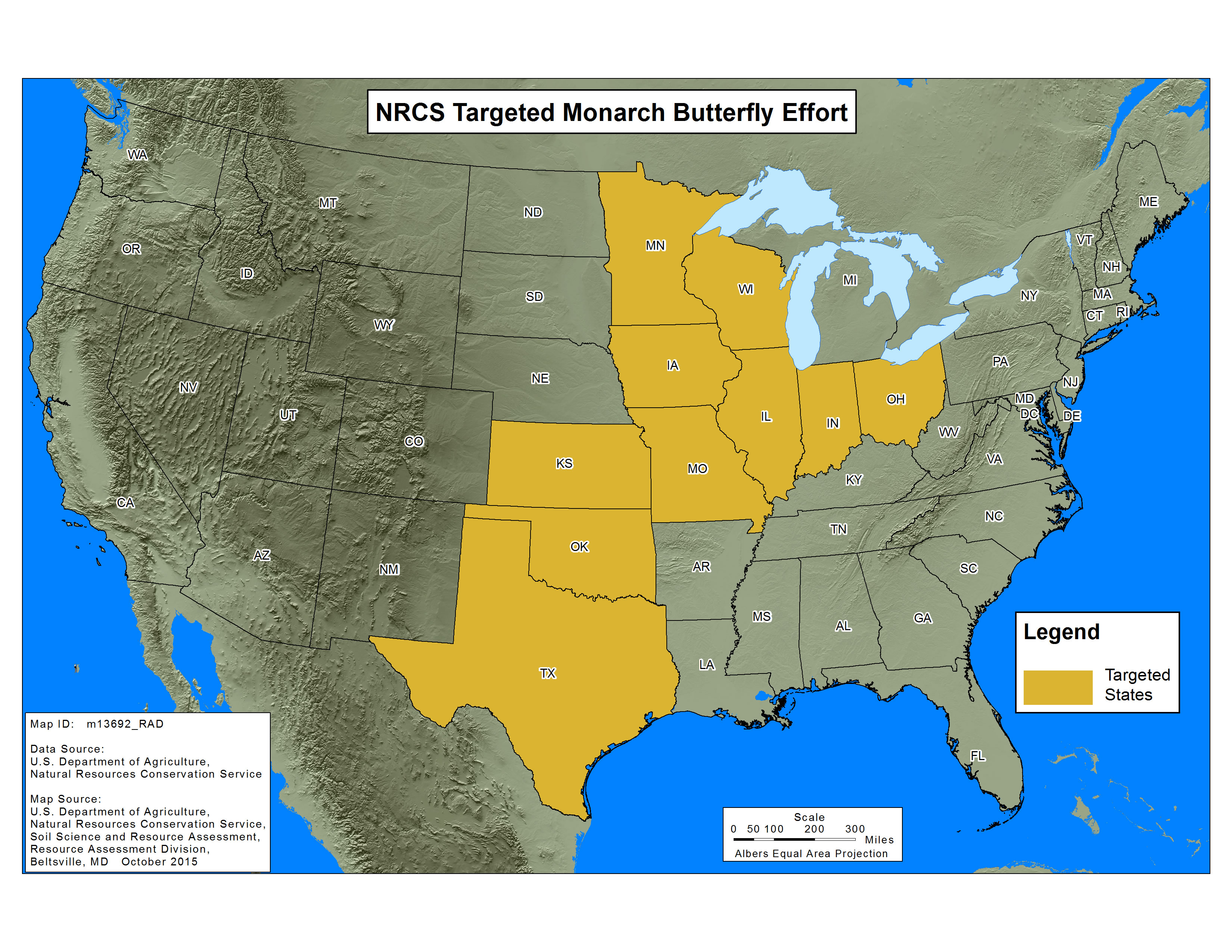
In November, The U.S. Department of Agriculture (USDA) announced a new conservation effort to help agricultural producers provide food and habitat for monarch butterflies in the Midwest and southern Great Plains. This targeted 10-state effort by USDA’s Natural Resources Conservation Service (NRCS) will invest $4 million in 2016 to help combat the iconic species’ decline.
“These once-common butterflies are growing less familiar, and we know private lands will continue to play a crucial role in aiding the recovery of this species that serves as an indicator of ecosystem health,” NRCS Chief Jason Weller said. “America’s farmers, ranchers and forest landowners are stewards of the land, and this effort helps them make voluntary improvements that benefit working lands and monarchs.”
NRCS Associate Chief Leonard Jordan unveiled this new conservation effort today in Kansas City, Missouri at the annual conference of the National Association of Farm Broadcasters. Missouri is one of the target states in this effort that benefits the orange-and-black butterflies known for their annual, multi-generational migration from central Mexico to as far north as Canada. Monarch populations have decreased significantly over the past two decades, in part because of the decrease in native plants like milkweed – the sole source of food for monarch caterpillars.
NRCS will provide technical and financial assistance to help producers and conservation partners plant milkweed and nectar-rich plants along field borders, in buffers along waterways or around wetlands, in pastures and other suitable locations. NRCS also help producers manage their pastures in ways that increase critical populations of milkweed and nectar plants while also improving the health of their rangelands.
Assistance is available to producers in Illinois, Indiana, Iowa, Kansas, Minnesota, Missouri, Ohio, Oklahoma, Texas and Wisconsin. These states are at the heart of the monarch migration. The Environmental Quality Incentives Program (EQIP) and remaining funds from the former Wetlands Reserve Program (WRP) provide funding for this work. Additionally, NRCS is offering support for related enhancements through the Conservation Stewardship Program (CSP) to establish monarch habitat. These enhancements are available nationwide.
NRCS accepts EQIP and CSP applications from producers on a continuous basis. Producers interested in participating should contact their local USDA service center to learn more. WRP funds will be used to enhance monarch habitat on existing wetland easements.
These conservation improvements not only benefit butterflies, they also strengthen agricultural operations, support other beneficial insects and wildlife and improve other natural resources. Appropriate buffer habitats and better rangeland and pasture management practices reduce erosion, increase soil health, inhibit the expansion of invasive species and provide food and habitat for insects and wildlife.
NRCS’ effort contributes to a multi-agency, international strategy to reverse the monarch’s population decline in North America, estimated to have decreased from one billion butterflies in 1995 down to about 34 million today. The Obama administration, through the National Strategy to Protect Pollinators and Their Habitat  , has a goal of increasing the eastern population of monarchs back up to 225 million by 2020.
, has a goal of increasing the eastern population of monarchs back up to 225 million by 2020.
Producers not in the regions targeted by this effort are also eligible for assistance to make conservation improvements to their land that can benefit monarch butterflies and many other pollinators, such as honey bees and native bees. More than three dozen conservation practices offered by NRCS can provide benefits to pollinators. Additionally, this effort works hand-in-hand with a three-year-old NRCS honey bee conservation effortin the Midwest and Northern Plains.
Learn more about the Monarch Habitat Development Project and other pollinators. For more on technical assistance and financial resources available through NRCS conservation programs, visit www.nrcs.usda.gov/GetStarted or a local USDA service center.


 , has a goal of increasing the eastern population of monarchs back up to 225 million by 2020.
, has a goal of increasing the eastern population of monarchs back up to 225 million by 2020.